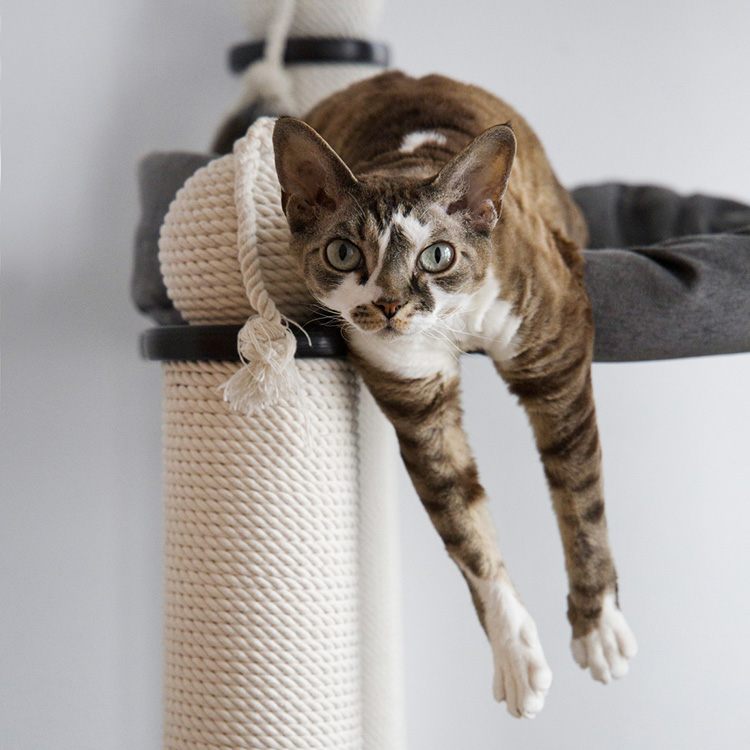BY JANELLE LEESON
Irina Ozhigova / Stocksy
It’s easy to get carried away when shopping for your new cat. Or to feel overwhelmed and not know where to start. Naturally, you want to welcome your new family member home with everything they need. If you’re bringing home a new cat or you’re considering adopting a cat, here’s everything you need to buy to be prepared.
Start with this new cat essentials checklist with all the cat necessities: food and water bowls, a litter box and litter, a scratching post, bedding, a carrier, food, toys, a collar and ID tag, grooming supplies, and cleaning supplies.
How should I plan and prepare for my new cat?
More than a few cat experts suggest preparing everyone in the family for the responsibilities of cat care. You’ll also want to set up a cat-friendly environment before a single toe bean ever enters the house. Designate a quiet space for your cat to gradually acclimate, establish a consistent routine, and prioritize regular veterinary checkups.
The advantage of setting up your home for your cat before they arrive is ensuring a comfortable and safe space for your kitty, as well as establishing clear roles and responsibilities for everyone else. All in all, a little prep will make the transition from the shelter to your home a smooth one.
To prepare your home and family for a new cat:
- Designate roles and responsibilities: Consider everything from cat care to food and litter box duties.
- Set house rules: Should the cat be allowed in the bedroom at night?
- Create a routine: Consider how often and when your cat will be fed.
- Prepare your cat’s safe space: The room should be a small, quiet room with essential supplies. They’ll stay in this room during the acclimation phase and should have access to the room as they continue settling in.
- Cat-proof your home: Protect your pet from potential hazards and secure breakable items.
- Shop for essential supplies: Explore what to buy for a new cat below.
- Choose a veterinarian: Your new cat requires a check-up soon after coming home.
- Prepare other pets: If applicable, get ready to introduce your dog to your new cat by practicing common training cues, such as sit, stay, and leave it.
What do you need to buy when bringing home a cat?
Sometimes, it’s smart to assess your cat’s preferences before sinking too much money into every popular bed, toy, tower, and treat. We’ve narrowed down this list of cat essentials for new pet parents, so you’ll have everything ready for your cat’s arrival, rather than leaving you with more cat supplies than you or your cat know what to do with.
Food and water bowls
If you’re adopting more than one cat or adding another one to your clower, each cat should have their own food bowl. Stainless steel, ceramic, or glass bowls are typically easiest to clean. Cats should also always have access to clean, fresh water. You might even consider getting a cat water fountain, as the filters keep water fresher for longer than a traditional bowl.
Litter boxes and litter
You’ll need one litter box per cat, plus an extra one. Place the boxes in quiet, easily accessible spots away from their food, water, and areas with high traffic or startling noises. Kittens and seniors tend to do best with low-entry litter boxes, and in general, cats should be able to comfortably turn around inside the litter box without touching the sides. As for the best cat litter, opt for a sand-like consistency without added perfumes, as these tend to be feline-friendly qualities.
Cat carrier
A comfortable and secure cat carrier is a must-have for bringing your cat home from the shelter and any future outings, such as routine vet visits. Carriers come in both soft-sided and hard-sided options, and they should provide a balance of privacy and ventilation. If you plan to travel by plane with your cat, look for an airline-approved cat carrier.
Scratching post
Cats’ scratching preferences can vary; some prefer vertical scratching surfaces, while others go for horizontal ones. And the type of material matters too–some cats love the feel of sisal, while others prefer to sink their claws into carpet or cardboard. When you’re not sure what your cat likes, you can start by offering a budget-friendly multi-surface scratcher or a corrugated cardboard one. Either way, offering your cat one or more appropriate places to scratch will save your furniture, floors, and mattress from potential damage.
Cat Bed
Provide your cat with a cozy place to rest. Because the transition from shelter to home can be a little overwhelming and scary for some cats, consider an enclosed bed such as a cat tent, cave, or cubby.
Collar and identification tag
The most common types of pet identification are microchips and a collar with an ID tag. Both work hand-in-hand to ensure your cat’s safe return if they ever wander off. Most shelters and rescues send newly adopted cats home with an implanted microchip. This tiny chip is inserted under the skin and, when scanned, populates pet parent information that helps reunite lost cats with their families.
While microchips are crucial, collars and tags offer immediate identification. Breakaway collars will unclip from themselves if snagged, offering an extra layer of safety. Ensure the tag includes your cat’s name and your phone number.
Grooming supplies
Even for short-haired cats, weekly brushing reduces shedding and hairballs while providing a bonding opportunity. It’s a good idea to keep up on clipping your cat’s nails too. To ensure grooming is a positive experience, reward your cat with a high-value treat after each session.
Cleaning supplies
Accidents are bound to happen, and when they do, you’ll be glad to have the best cleaners for pet messes on hand. Enzymatic pet cleaners are your best bet because they break down uric acid in pet urine to eliminate odors, rather than cover them up.
Toys
Having a few toys on hand is a good idea because cats require at least 30 minutes of daily play. Kicker toys are great for getting out pent-up energy, plus some cats find comfort in licking those that contain catnip. Experts also recommend wand toys for building bonds with new or shy cats. Just remember to store them safely after each session to avoid string-related hazards. While you’re still discovering what your new cat enjoys playing with, try a few DIY or free cat toys.
What do you need to buy when bringing home a new kitten?
Purchasing supplies for a kitten isn’t all that different from the supplies for an adult cat. That said, there are a few key differences in cat supplies made for adults, seniors, and kittens. Here’s what to keep in mind when shopping for a new kitten:
- Low-entry litter box: Kittens have short legs and need a litter box with a low entrance for easy access. The same can be said for senior cats who may have arthritis.
- Easy-to-access food and water bowls: Opt for bowls that are shallow enough for kittens to comfortably eat and drink without straining their necks.
- Scratching posts and climbing structures: Kittens tend to be more curious and have more energy than adult cats. Provide them with safe and stimulating climbing structures, such as cat trees or shelves, to exercise and explore their surroundings safely. While they may need more options for climbing and scratching, kittens and adult cats can typically use the same furniture.
- Kitten food: Cat food is formulated to meet the specific nutritional needs of cats at different stages of life. Kittens, for instance, must eat food labeled as kitten food for growth or all life stages food. These foods contain all the nutrients kittens require to grow into healthy adults. Once your kitten reaches adulthood, around a year old, switch to adult cat food formulated for maintenance. If you have any questions about what food to feed your cat, how much, or how often, consult your veterinarian.
What toys are appropriate for a new kitten?
When purchasing toys for a new kitten, consider ones that encourage your kitten to stalk and pounce, such as wand toys with feathers. They’re not only fun for your kitten, but also help build a bond between you and them. Like adult cats, kittens also enjoy toys they can bat around on their own, such as toy mice. And catnip-filled toys are great for kicking.
Safety tip: When choosing kitten-appropriate toys, avoid anything with small parts such as buttons, that could be a choking hazard. After play sessions, safely store any toys with strings that could pose a hazard.
FAQs (People also ask):
What should I do to cat-proof my home?
When making your home more cat-friendly, you’ll want to protect your cat from hazards and your belongings from damage. Cover electric cords, cables, and phone chargers to prevent your cat from chewing on them, which can lead to serious injury. Keep cupboards, especially those containing cleaning supplies and medications, securely locked. Keep an eye out for other hazards, too, such as dropped medications or sharp objects, and move toxic plants out of the house or out of reach. Want to redirect destructive behaviors such as scratching the furniture? Provide plenty of toys, scratching surfaces, climbing structures, and hiding spots.
Should I have pet insurance before bringing home my new cat?
Purchasing a pet insurance plan as soon as possible could be a smart move. Just as you might want health insurance before you get sick, the same goes for your cat.
When should I take my new cat to the vet for the first time?
Even if your new cat comes with a clean bill of health and all their shots, it’s still a good idea to get them checked out by a vet soon after adoption. It’s a chance to ask new cat-parent questions, get familiar with the clinic, and establish a relationship with your veterinarian. If you’re adopting a kitten rather than an adult cat, you’ll be seeing the vet quite often after adoption because they’ll need a series of vaccinations over the next few weeks and months.
Janelle Leeson is a Portland, Oregon-based freelance writer. Her work has been featured in magazines such as Inside Your Dog’s Mind, Inside Your Cat’s Mind, and Paw Print, as well online at Insider Reviews, NBC Select, Shop Today, PetMD, and Daily Paws. She has two adventure cats, a flock of urban chickens, and a soon-to-be-husband who doesn’t mind housing the occasional foster cat — or five



